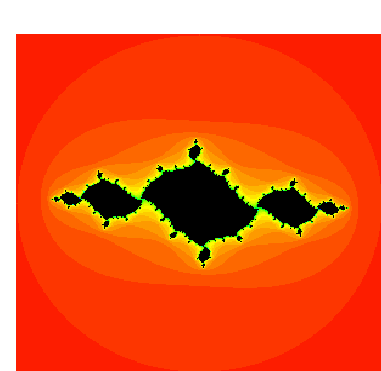
c = -1.037 + 0.17i in a period 2 bulb

c = -0.52 + 0.57i in a period 5 bulb

c = 0.295 + 0.55i in a period 4 bulb

c = -0.624 + 0.435i in a period 7 bulb.
Figure 7. Julia sets for several c-values
The Julia set for x2 + c is subtly different from the Mandelbrot set. For M, we calculated only the orbit of 0 for each c-value and then displayed the result. A c-value lies in M if the corresponding orbit of 0 does not escape to infinity. Thus, M is a picture in the c-plane, the parameter plane.
For the Julia sets, we fix a c-value and then consider the fate of all possible seeds for that fixed value of c. Those seeds whose orbits do not escape form the Julia set of x2 + c. Orbits that do escape do not lie in the Julia set. Thus we get a different Julia set of each different choice of c. That is, the Julia set is a picture in the dynamical plane, not the parameter plane. We denote the Julia set for x2 + c by Jc. In Figure 7 we have displayed the Julia sets for a variety of c-values.

c = -1.037 + 0.17i in a period 2 bulb

c = -0.52 + 0.57i in a period 5 bulb

c = 0.295 + 0.55i in a period 4 bulb

c = -0.624 + 0.435i in a period 7 bulb.
Figure 7. Julia sets for several c-values
It follows that any seed on or inside the circle of radius 1 centered at the origin has an orbit that does not escape to infinity. It therefore follows that J0 consists of all those seeds whose orbits lie on or insider the unit circle centered at the origin.
Incidentally, the fate of orbits of x2 that lie on the unit circle is quite an interesting story. These are precisely the orbits that behave in a chaotic fashion. See [3] for more details.
Other Julia sets are much more difficult to compute. To see them, we
must use a computer. The algorithm is, of course, a direct consequence
of the definition of Jc. We simply consider a grid of
points centered at the origin and compute the orbit of each of these points
under x2 + c. Either this orbit tends to infinity (in
which case the seed was not in Jc) or else the orbit
does not (and so the seed lies in Jc).
The Mandelbrot set: